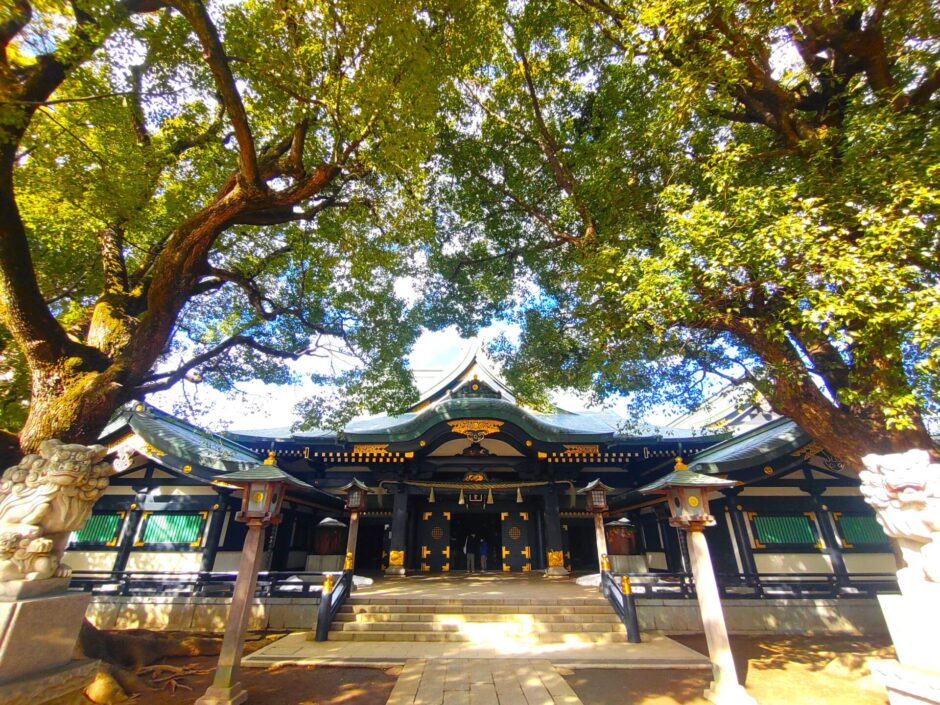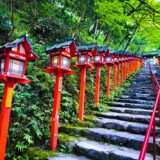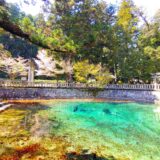【summary】
Ana Hachimangu Shrine was founded in 1062, when Minamoto no Yoshie invited Hachimangu Shrine, the deity of the shrine, to this area. 1641, when the south side of the shrine was being cut, a side hole was found, and a gilt bronze statue of the Buddha, Ayodahachimangu, was found inside, which gave rise to the name of the shrine. The shrine is known for its good luck in business and money, and is one of the most visited shrines in Tokyo. 1945 Tokyo Air Raid destroyed most of the buildings, but in 1961, reconstruction work began on the main shrine as part of the 900th anniversary of the shrine’s establishment. The deity is Emperor Ojin (Hondawake no Mikoto/Hindawake no Mikoto), his father and mother, Emperor Nakai and Empress Jingu (Princess Kichonatarashihime).
【premises】
![Ana Hachimangu Shrine [Tokyo] DSC 0802 1024x768 - Ana Hachimangu Shrine [Tokyo]](https://japan-shrine.info/wp-content/uploads/DSC_0802-1024x768.jpg)
The front approach torii gate of Ana Hachimangu Shrine is a short walk from the Waseda Subway Station. The large vermilion torii gate in the middle of the city is a beautiful contrast to its surroundings.
![Ana Hachimangu Shrine [Tokyo] DSC 0825 1024x768 - Ana Hachimangu Shrine [Tokyo]](https://japan-shrine.info/wp-content/uploads/DSC_0825-1024x768.jpg)
There is a dynamic sculpture, Takadanobaba Yabusame (horseback archery) next to the torii gate. Takadanobaba Yabusame (traditional horseback archery) is held every year in October at nearby Toyama Park, but in the past it was held in the precincts of Ana Hachimangu Shrine, and there is a magnificent horseback archery statue right next to the torii (gate). It is a valuable traditional event that has been handed down to the present day as a ritual of Ana Hachimangu Shrine. Matsudaira Naotsugu, a samurai residing in Waseda who was the head of the go-mochi archery team of the Shogunate, built a target area for archery practice and operated a small shrine of Hachiman God, the patron god of bow and arrow.
![Ana Hachimangu Shrine [Tokyo] DSC 0803 1024x768 - Ana Hachimangu Shrine [Tokyo]](https://japan-shrine.info/wp-content/uploads/DSC_0803-1024x768.jpg)
The shrine was originally called “Takada Hachiman” (meaning “Takada Hachiman” in Japanese), but the discovery of a cave in the early Edo period (1603-1868), in which a 10 cm high gilt bronze statue of the Buddha Amitabha was found, brought many visitors to the shrine. Ana Hachimangu Shrine stands on the edge of a plateau, and there are various theories as to whether the cave in the plateau was a cave tomb built in the early Nara period (710-794) or a burial mound built even earlier.
![Ana Hachimangu Shrine [Tokyo] DSC 0805 1024x768 - Ana Hachimangu Shrine [Tokyo]](https://japan-shrine.info/wp-content/uploads/DSC_0805-1024x768.jpg)
After climbing up Otokozaka, you will see a brand-new shrine gate (Koryomon). After passing through the gate, you will see the spacious precincts with a solemn black worship hall, the shrine office, and a camphor tree, which you can tell is long in age. The temple grounds are surrounded by a tranquil atmosphere in spite of being in the city, and your mind is calm and tightened.
![Ana Hachimangu Shrine [Tokyo] DSC 0813 1024x768 - Ana Hachimangu Shrine [Tokyo]](https://japan-shrine.info/wp-content/uploads/DSC_0813-1024x768.jpg)
I was surprised at the surprisingly large size of this urban shrine. When I visited the shrine, the grounds were quiet and the sun was shining down comfortably.
![Ana Hachimangu Shrine [Tokyo] DSC 0819 1024x768 - Ana Hachimangu Shrine [Tokyo]](https://japan-shrine.info/wp-content/uploads/DSC_0819-1024x768.jpg)
Since the Edo period (230 years ago), many people have lined up on the winter solstice day for the “Ichiyo Raigai Mamori” amulet, which is distributed from 5:00 a.m. on the morning of the winter solstice until the day of Setsubun. The “Ichiyo Raigai Mamochi” has been distributed at Ana Hachimangu Shrine from 1688 to the present. The reason why this amulet has the meaning of the Winter Solstice and the reconciliation of gold and silver is due to the Uchide-kozuchi (a small mallet with a hammer attached) that is kept inside. It is said to be a treasured vessel given to Emperor Shomu by the dragon god on the winter solstice in the Nara period (710-794).
![Ana Hachimangu Shrine [Tokyo] DSC 0821 1024x768 - Ana Hachimangu Shrine [Tokyo]](https://japan-shrine.info/wp-content/uploads/DSC_0821-1024x768.jpg)
There is a far-off place of worship for Emperor Jinmu. The far worship place was established for worshipping the gods and Buddha from far away. Emperor Jinmu is the first emperor in Japanese mythology. It is said that from this place, one can worship in the direction of Kashihara Shrine in Nara Prefecture, which is located far to the southwest.
【Nearby attractions】
![Ana Hachimangu Shrine [Tokyo] DSC 0514 1 160x160 - Ana Hachimangu Shrine [Tokyo]](https://japan-shrine.info/wp-content/uploads/DSC_0514-1-160x160.jpg) Zoshigaya Kishimojin Hall (Houmyouji Temple) [Tokyo]
Zoshigaya Kishimojin Hall (Houmyouji Temple) [Tokyo]
【Access】
Manager’s Comments
Personally, I like quiet shrines, so I visited at different times of the year. I would like to get the Ichiyo-rikaichi amulet if possible, but it may be impossible to wait in line for hours. The Hachiman-sama has a solemn atmosphere in spite of its location in the city.
1-11, Nishi-Waseda 2-chome, Shinjuku-ku, Tokyo 162-0051, Japan
※No parking is available.
 Tour of Japanese shrines and temples
Tour of Japanese shrines and temples 

![Ana Hachimangu Shrine [Tokyo] DSC 03512 150x150 - Ana Hachimangu Shrine [Tokyo]](https://japan-shrine.info/wp-content/uploads/DSC_03512-150x150.jpg)
![Ana Hachimangu Shrine [Tokyo] 23740271 m 150x150 - Ana Hachimangu Shrine [Tokyo]](https://japan-shrine.info/wp-content/uploads/23740271_m-150x150.jpg)
![Ana Hachimangu Shrine [Tokyo] DSC 0290 150x150 - Ana Hachimangu Shrine [Tokyo]](https://japan-shrine.info/wp-content/uploads/DSC_0290-150x150.jpg)
![Ana Hachimangu Shrine [Tokyo] DSC 0834 150x150 - Ana Hachimangu Shrine [Tokyo]](https://japan-shrine.info/wp-content/uploads/DSC_0834-150x150.jpg)

